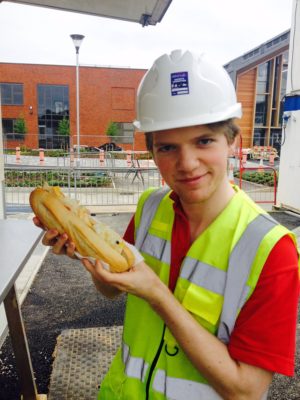To YINI and Beyond!

Engineering Intern Edward Saunders talks about his experiences of the Year in Industry scheme as he approaches the end of his 12 month industrial placement. Breathing Buildings are strong supporters of YINI, we work closely with the Engineering Development Trust, EDT, and take great pride in helping to develop the next generation of world-leading engineers.
“I am now coming to the end of my year in industry. I have been working in the consulting engineers team, getting involved with doing projects, testing, and even consultancy work. To do my placement, I moved into a house share in a city that was not my home, and lived independently learning life’s basic skills whilst getting fully immersed into a high-energy work environment!
“In my first few weeks I always seemed to be tired. Getting used to office hours, looking after myself, and a week spent at the company’s factory took some adjustment. These first few weeks were also rather daunting. I was introduced to one of the company’s outgoing YINI students. His knowledge of the work and seemingly everything around it was astonishing considering he had only been in the company for a year and had not even begun his degree. I thought to myself, “Is this where I am meant to be in a year’s time?” and, “How can I possibly get to that point?”. It was a steep learning curve for me. I struggled to get quickly to grips with the theory behind what I was already putting into practice – though, in retrospect, that’s probably the experience of every YINI student thrown in at the deep end. Fortunately for me, someone at Breathing Buildings was always willing to help, and I got there eventually.
“Being in the consulting engineers team, I have spent most of my time doing design work. This means collating information, deciding on reasonable assumptions where information is not available, and using this to simulate buildings with our in-house dynamic thermal modelling software. The model helps to predict how individual rooms would perform over the year, against regulatory overheating criteria. The design is then written up in a proposal document and sent to the client to go back and forth until the design is finalised. I been involved in somewhere north of one hundred projects, and I find it greatly satisfying that, so early, my engineering work is having a real-world impact. When I gather information for a project, it is wise to remember that a building may not always end up looking exactly like the architect’s plans I’ve received. For example, not only might the type of glazing used in the windows change during the evolution of a design, the number and size of them might change too! The skill of dealing with uncertainty is something I’m still working on. One of the main things I have learnt this year is that my idea of what an expert is was wrong. I thought that, once you obtain the right qualifications, you become an expert in a flash. This has not been my experience. I have found that without having any qualifications, you ask all the other experts in your field questions until, one day, you realise that you are now an expert yourself in very specific areas. There isn’t a secret trick; it turns out most people are also just trying to work it all out too.
“What has been the highlight so far of my year? One comes from what might have been the deadly task of reading through several regulatory documents. My job was to summarise them in the more palatable form of an infographic. These are not the most eloquently written documents, and I had to learn how to read and interpret this kind of text. It took me a couple of combs through to collect all of the data I needed. This wasn’t helped by the fact that one unreleased document was in the process of being edited, which required me to go back and change the infographic. I made a few drafts (I knew my GCSE Art would be useful one day) and had them reviewed by colleagues. When we were happy with it, it was sent off to some graphics people to be neatened up. It was originally intended just to be for our sales literature and website, but the infographic ended up appearing in the CIBSE Journal. This task allowed me to use my more artistic side, and I’m quite proud of the end result (I’m sure the Turner prize is on its way now).
“I would like to thank all of the team at Breathing Buildings for putting up with me this year. The company feels like a big (if slightly zany) family, and I’ve always felt welcome. I have learnt a lot this year, have had a wide range of experiences of working in the industry, and I would recommend it to any enterprising prospective engineers. You’ll never know where it might take you. Doing a YINI placement is by no means easy; there will be times when it is hard work or no fun at all, but you can learn from them. In my experience, this year has required a lot of independence. Your job is very much what you make of it, as is the life you make outside of it too.”
